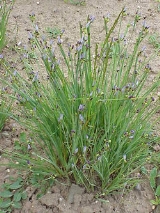
Sisyrinchium montanum
Encyclopedia
Sisyrinchium montanum, or strict blue-eyed grass, is a grass-like species of plants from the genus
Sisyrinchium native to northern North America
from Newfoundland west to easternmost Alaska
, and south to Pennsylvania
in the east, and to New Mexico
in the Rocky Mountains
.
It is very similar to S. angustifolium
, with which it is sometimes combined.
perennial plant
that grows in clumps between 10–50 cm tall. Its stem
s have wings with entire to finely toothed margins. The leaves
and stem are slender, 3 mm broad, green or brownish, with sharp edges and a fine point.
The flower
s are produced in a small cyme of two to five together emerging from a spathe, each flower about 2 cm diameter, with six purplish tepal
s with a yellowish base and yellow stamens. The fruit
is a capsule
4.5–6 mm long, containing numerous small black seed
s.
Genus
In biology, a genus is a low-level taxonomic rank used in the biological classification of living and fossil organisms, which is an example of definition by genus and differentia...
Sisyrinchium native to northern North America
North America
North America is a continent wholly within the Northern Hemisphere and almost wholly within the Western Hemisphere. It is also considered a northern subcontinent of the Americas...
from Newfoundland west to easternmost Alaska
Alaska
Alaska is the largest state in the United States by area. It is situated in the northwest extremity of the North American continent, with Canada to the east, the Arctic Ocean to the north, and the Pacific Ocean to the west and south, with Russia further west across the Bering Strait...
, and south to Pennsylvania
Pennsylvania
The Commonwealth of Pennsylvania is a U.S. state that is located in the Northeastern and Mid-Atlantic regions of the United States. The state borders Delaware and Maryland to the south, West Virginia to the southwest, Ohio to the west, New York and Ontario, Canada, to the north, and New Jersey to...
in the east, and to New Mexico
New Mexico
New Mexico is a state located in the southwest and western regions of the United States. New Mexico is also usually considered one of the Mountain States. With a population density of 16 per square mile, New Mexico is the sixth-most sparsely inhabited U.S...
in the Rocky Mountains
Rocky Mountains
The Rocky Mountains are a major mountain range in western North America. The Rocky Mountains stretch more than from the northernmost part of British Columbia, in western Canada, to New Mexico, in the southwestern United States...
.
It is very similar to S. angustifolium
Sisyrinchium angustifolium
Sisyrinchium angustifolium, commonly known as Stout blue-eyed grass or simply blue-eyed grass, is a herbaceous perennial growing from rhizomes, native to moist meadow and open woodland. It is the most common blue-eyed grass of the eastern United States.Height: . Stem: broadly winged, wide. Leaves:...
, with which it is sometimes combined.
Description
Sisyrinchium montanum is a herbaceousHerbaceous
A herbaceous plant is a plant that has leaves and stems that die down at the end of the growing season to the soil level. They have no persistent woody stem above ground...
perennial plant
Perennial plant
A perennial plant or simply perennial is a plant that lives for more than two years. The term is often used to differentiate a plant from shorter lived annuals and biennials. The term is sometimes misused by commercial gardeners or horticulturalists to describe only herbaceous perennials...
that grows in clumps between 10–50 cm tall. Its stem
Plant stem
A stem is one of two main structural axes of a vascular plant. The stem is normally divided into nodes and internodes, the nodes hold buds which grow into one or more leaves, inflorescence , conifer cones, roots, other stems etc. The internodes distance one node from another...
s have wings with entire to finely toothed margins. The leaves
Leaf
A leaf is an organ of a vascular plant, as defined in botanical terms, and in particular in plant morphology. Foliage is a mass noun that refers to leaves as a feature of plants....
and stem are slender, 3 mm broad, green or brownish, with sharp edges and a fine point.
The flower
Flower
A flower, sometimes known as a bloom or blossom, is the reproductive structure found in flowering plants . The biological function of a flower is to effect reproduction, usually by providing a mechanism for the union of sperm with eggs...
s are produced in a small cyme of two to five together emerging from a spathe, each flower about 2 cm diameter, with six purplish tepal
Tepal
Tepals are elements of the perianth, or outer part of a flower, which include the petals or sepals. The term tepal is more often applied specifically when all segments of the perianth are of similar shape and color, or undifferentiated, which is called perigone...
s with a yellowish base and yellow stamens. The fruit
Fruit
In broad terms, a fruit is a structure of a plant that contains its seeds.The term has different meanings dependent on context. In non-technical usage, such as food preparation, fruit normally means the fleshy seed-associated structures of certain plants that are sweet and edible in the raw state,...
is a capsule
Capsule (fruit)
In botany a capsule is a type of simple, dry fruit produced by many species of flowering plants. A capsule is a structure composed of two or more carpels that in most cases is dehiscent, i.e. at maturity, it splits apart to release the seeds within. A few capsules are indehiscent, for example...
4.5–6 mm long, containing numerous small black seed
Seed
A seed is a small embryonic plant enclosed in a covering called the seed coat, usually with some stored food. It is the product of the ripened ovule of gymnosperm and angiosperm plants which occurs after fertilization and some growth within the mother plant...
s.

